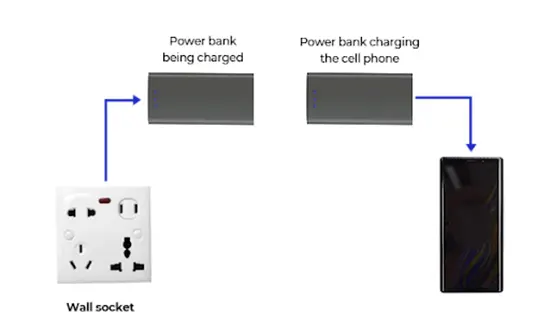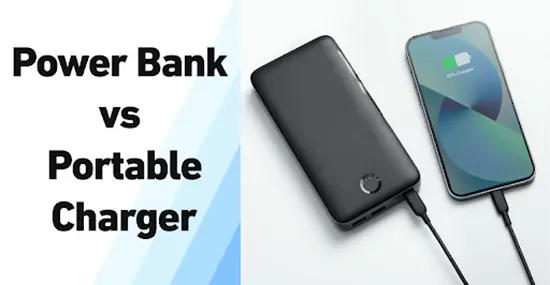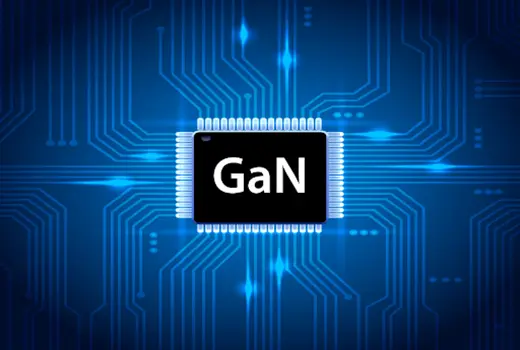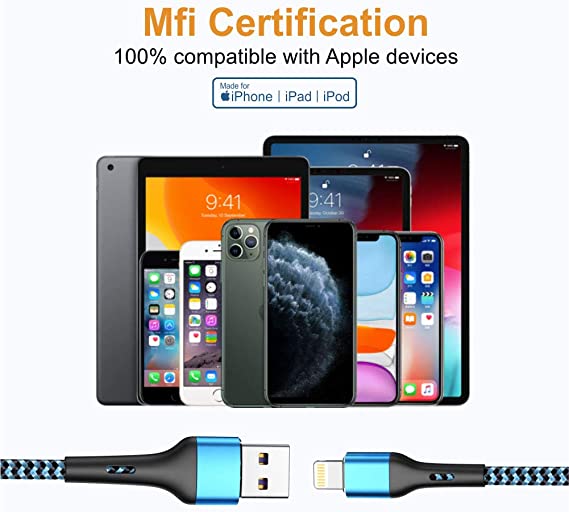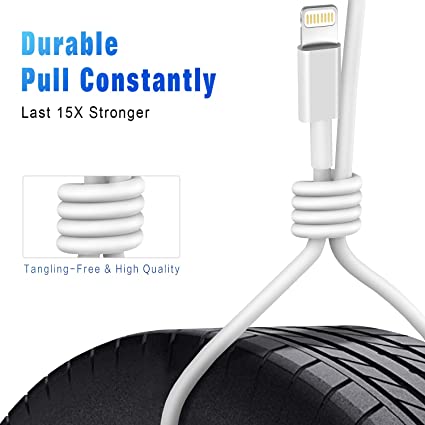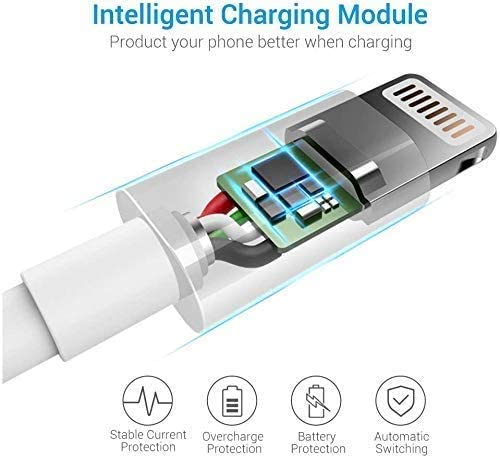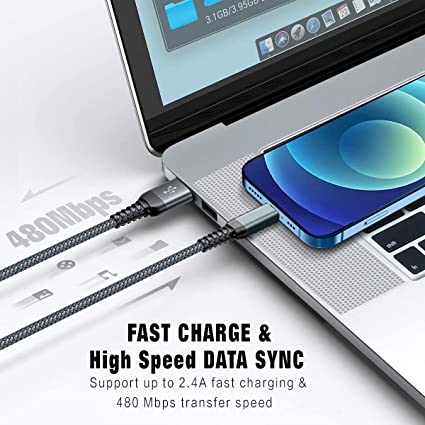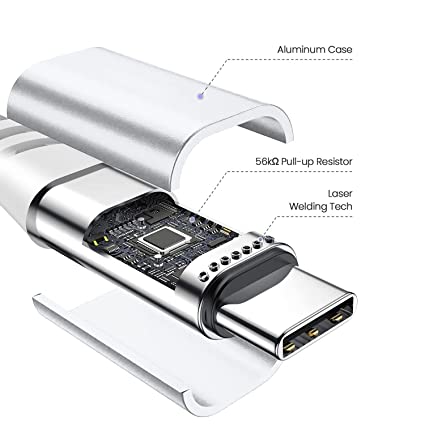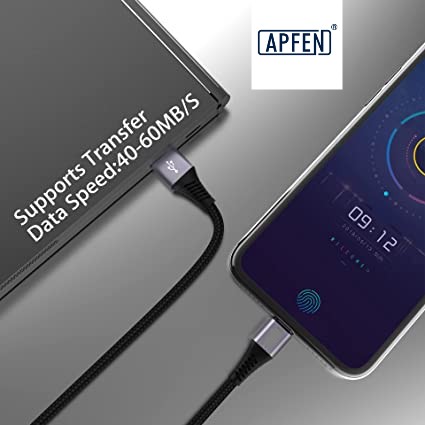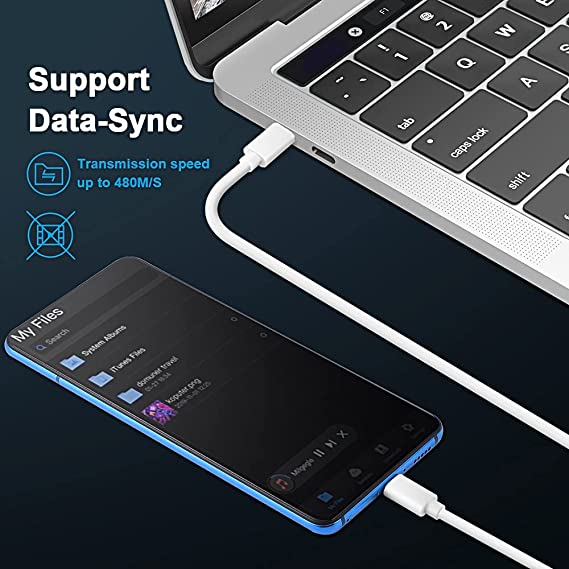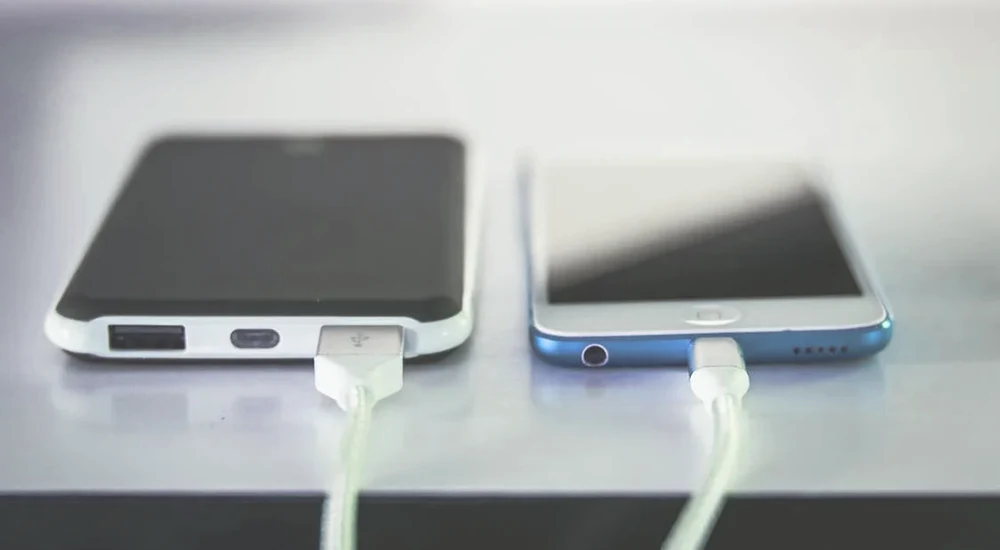Guide to how Power Banks work and types.
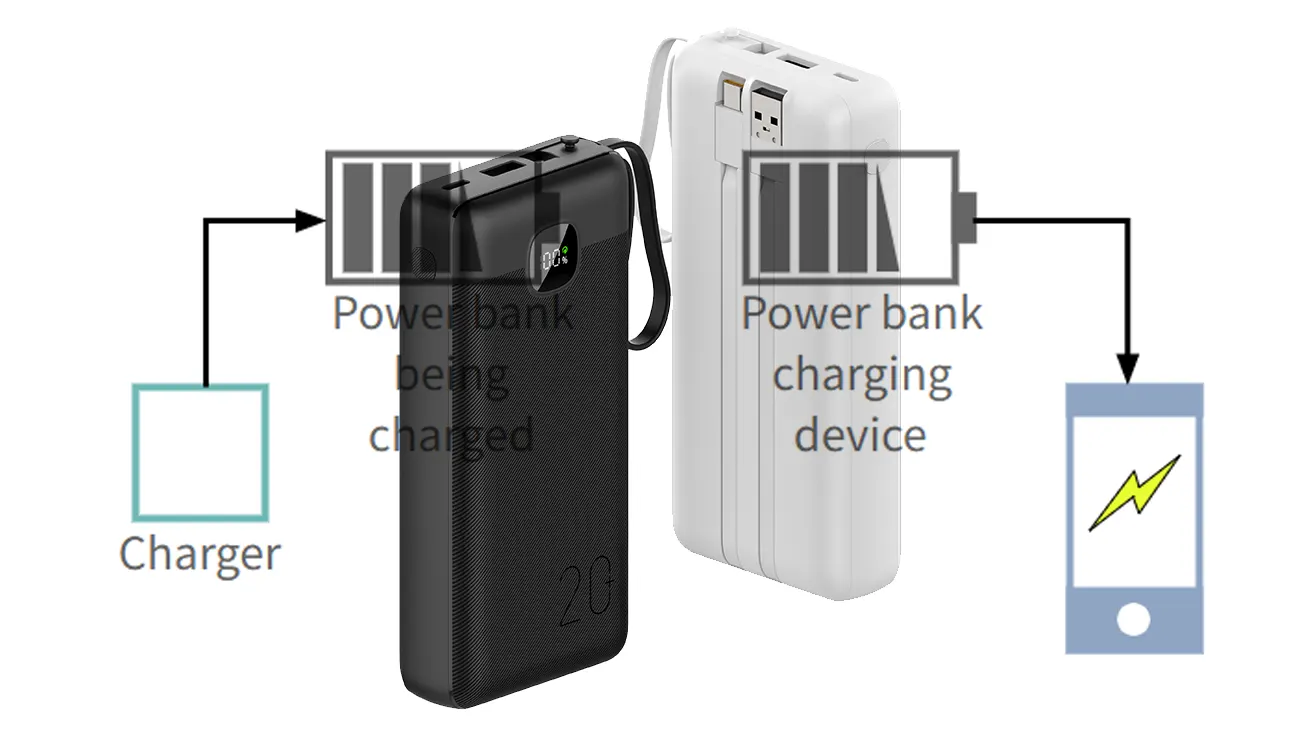
You’re on a trip, enjoying your day, and suddenly your phone flashes that dreaded red battery warning. No charger, no outlet, and nowhere near home. It’s a frustrating moment we’ve all experienced. In today’s world, where staying connected is almost necessary, running out of battery feels like being cut off completely. That’s exactly why power banks have become such an essential part of everyday life. Whether you’re a traveller, a student, or someone who simply uses their phone a lot, a power bank can be a total lifesaver. It’s like carrying a spare battery in your pocket, ready to bring your phone or any other device back to life when you need it most.
But have you ever wondered how these little gadgets actually work? Why are there so many different sizes, capacities, and features? And what’s next for portable charging tech? Let’s find out how power banks work in simple terms, what the different types available today are, and even take a look at the exciting future of battery technology.
What Is A Power Bank?
A power bank is essentially a portable battery that allows you to charge electronic devices like smartphones, tablets, and laptops on the go. A power bank you can carry anywhere and use to recharge your electronic devices on the go. It’s like having your own backup power station tucked neatly in your backpack or pocket. Whether you’re on a long flight, hiking in the mountains, stuck at a conference with no wall outlet in sight or just forgot to plug in last night, your power bank becomes your best friend. Power banks come in all shapes and sizes. Some are small and slim, perfect for just one full phone charge. Others are larger, powerful enough to charge a laptop or keep multiple devices running for days. Most of them use USB-A or USB-C ports, which makes them super versatile; you can charge pretty much anything with a USB cable.
But what really makes one power bank different from another? That comes down to two things:
- Capacity, measured in milliamp-hours (mAh), tells you how much charge it holds. The higher the mAh, the more times you can charge your device before the power bank itself needs to be recharged.
- Power efficiency, measured in watt-hours (Wh), tells you how fast and efficiently it can deliver that charge. A high Wh rating means it can charge your phone, tablet, or laptop more quickly.
To put it simply:
- A 10,000mAh power bank might charge your phone 2 to 3 times.
- A 20,000mAh one could charge your phone 4 to 5 times, or power up a tablet or even a lightweight laptop.
- And if it supports fast charging, you won’t be stuck waiting around for hours.
What makes power banks even more amazing is how lightweight and portable they’ve become. You can toss one into your bag without even noticing the extra weight. For travellers, students, remote workers, and literally anyone who uses a smartphone a lot, a power bank is no longer just a “nice-to-have”; it’s a must. In short, a power bank is peace of mind. It’s freedom from wall outlets. It’s your ticket to staying connected wherever life takes you.
How Does A Power Bank Work?
Now we know what a power bank is, but how does it actually work? Think of it like a mini fuel tank for your phone or tablet. At the heart of every power bank are special batteries, usually lithium-ion or lithium-polymer. These are powerful types of batteries that store electrical energy, kind of like a water tank stores water. When you plug your phone or tablet into the power bank, this stored energy is transferred through a USB cable and flows into your device, charging it up.
Charging the power bank itself is just as easy. You plug it into a wall socket using an adapter and a USB cable, just like you would with your phone. The energy flows into the internal battery, gets stored there, and waits until you need it. But there’s more happening inside than just charging. A smart circuit board manages the entire process. It makes sure your power bank charges safely, doesn’t overheat, and knows exactly how much energy your device needs. That way, your gadgets are protected from overcharging or getting too much power.
Most power banks also come with multiple ports, which means you can charge more than one device at a time. Whether it’s your phone, your friend’s earbuds, or your smartwatch, a good power bank has you covered. You’ll also see numbers like 10,000mAh or 20,000mAh printed on power banks. This stands for milliamp-hours, a fancy term that simply tells you how much power it can store. The higher the number, the more times you can charge your device.
So, in short, inside a power bank are lithium-ion or lithium-polymer batteries that store electrical energy. This energy is transferred to your device via a USB cable as soon as you connect it. The power bank itself is charged via a socket using an adapter and a USB cable. This works similarly to charging a cell phone. So, a power bank stores energy, holds onto it until you need it, and then safely passes it over to your device anytime, anywhere.
To conclude, a power bank stores energy, then safely transfers it to your devices when you need it,t whether you’re in bed, on a train, or halfway up a mountain.
What Is the Difference Between a Power Bank and a Portable Charger?
Is there a real difference between them? At their core, both power banks and portable chargers serve the same purpose: Both are rechargeable battery packs designed to charge electronic devices without the need for a direct power source. They store electrical energy to recharge your devices on the go. Whether you’re travelling, commuting, or simply away from a power outlet, these handy gadgets ensure your smartphone, tablet, or other electronic devices stay powered up. The distinction lies primarily in terminology and marketing.
Power Bank: The Technical Term.
The term power bank is often used in technical contexts or product listings. It emphasises the device’s ability to “bank” power, storing energy for later use. Power banks come in various capacities, typically measured in milliamp-hours (mAh), indicating how much charge they can hold. Higher mAh ratings mean more power storage, allowing multiple device charges before needing a recharge themselves.
Portable Charger: The Everyday Term.
On the other hand, portable charger is a more casual term that highlights the device’s portability and charging function. It’s the term most people use in everyday conversations. Portable chargers are designed to be lightweight and compact, making them easy to carry in a bag or pocket.
While the terms power bank and portable charger are often used interchangeably, there are subtle distinctions between them worth understanding. Typically, a power bank refers to a device with a larger battery capacity, designed to charge multiple devices or provide several full charges to a single device. These are particularly useful for long trips, travel, or scenarios where access to mains power is limited. On the other hand, a portable charger usually places more emphasis on being compact and lightweight. Its design caters to users who value portability and need a convenient backup for daily commutes or occasional top-ups throughout the day.
When deciding between the two, it really comes down to your personal habits and charging needs. If you’re someone who frequently travels, uses multiple devices, or needs to power higher-wattage gadgets like tablets or laptops, a higher-capacity power bank will offer the endurance and output necessary to stay connected. However, if you just need a quick boost for your phone or earbuds during your daily routine, a sleek, pocket-sized portable charger may be more than enough.
What Are the Different Types of Power Banks?
In our power bank journey so far, we’ve covered how these portable chargers work and what features to look for when buying one. Now, let’s dive into the exciting part – exploring the diverse world of power bank varieties available today. Just like smartphones come in different shapes and sizes for various needs, power banks have evolved far beyond basic battery packs. Modern options range from ultra-slim pocket-sized chargers to massive capacity beasts that can power your laptop. Some even harness solar energy or attach magnetically to your phone for cable-free convenience. Power banks have two key aspects,
- Their internal battery composition (what makes them tick).
- Their functional designs (how they meet different user needs).
Battery Composition:
When it comes to choosing the right power bank, one of the most important factors to consider is the type of battery inside. It directly affects how the power bank performs, how heavy it is, and how long it lasts over time. Let’s break down the two most common types of batteries used in power banks:
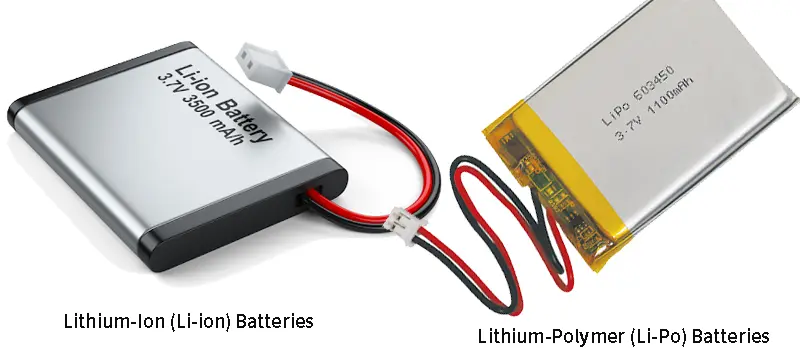
- Lithium-Ion (Li-ion) Batteries.
Li-ion batteries are the go-to choice for many electronics, and they’re widely used in power banks for good reason. They pack a lot of energy into a small space, making them efficient at storing power. This high energy density means you can get more charges out of a smaller battery. They’re also generally more affordable than other options and, with proper care, can last for several years. However, they do have some trade-offs. Li-ion batteries are slightly heavier, and over time, they can degrade faster if they’re left unused or stored improperly. So if you’re not using your power bank regularly, you might notice it doesn’t hold a charge as well as it used to. - Lithium-Polymer (Li-Po) Batteries.
Li-Po batteries are a bit more advanced and often used in premium or compact power banks. They’re known for being lightweight and flexible — literally. Manufacturers can mould them into various shapes, which allows for thinner, more portable designs. They’re also considered safer in many cases, as they’re less likely to leak or swell compared to Li-ion batteries. On the flip side, they usually cost more, and while they may not last significantly longer in terms of charge cycles, they’re often chosen for their safety and design benefits.
Functional Categories:
Not all power banks are created equal. Beyond just battery type, power banks come with different features and use cases in mind. Whether you need something simple for your phone or something powerful enough to charge a laptop, there’s a model out there for you.
- Standard Portable Power Banks.
These are your everyday chargers, designed to provide a reliable power source for smartphones, tablets, and other small devices. They typically range from 5,000mAh to 10,000mAh, offering one to two full charges for most smartphones. Their compact size makes them ideal for daily use and short trips. - High-Capacity Power Banks.
For those requiring more power, high-capacity power banks offer 20,000mAh or more. They’re perfect for charging multiple devices or providing several charges to a single device. Some models can even charge laptops, making them suitable for business travelers or digital nomads. However, their larger size and weight may not be as convenient for everyday carry. Fast-Charging Power Banks
Time is of the essence, and fast-charging power banks cater to that need. Equipped with technologies like Power Delivery (PD) or Quick Charge (QC), these power banks can significantly reduce charging times. They’re especially beneficial for devices that support fast charging, ensuring you spend less time tethered to a charger.Wireless Charging Power Banks
Embracing the wireless revolution, these power banks allow you to charge your devices without any cables. Simply place your Qi-compatible device on the power bank’s surface, and charging begins. Some models also combine wireless and wired charging, offering versatility for various devices.Magnetic Power Banks
Designed with convenience in mind, magnetic power banks attach directly to the back of compatible smartphones, such as those with MagSafe technology. This feature ensures a secure connection, allowing you to use your phone while it charges without the hassle of cables.
Solar Power Banks
If you spend a lot of time outdoors or want a more eco-friendly charging option, solar power banks are worth considering. They recharge using sunlight, which is great for hiking, camping, or emergency preparedness. Just keep in mind: solar charging is slow and best used as a backup rather than your main source of power.
Power Banks with Built-in Cables
Say goodbye to tangled cords. These power banks come with integrated charging cables, ensuring you’re always prepared. Some models include multiple cable types, catering to various devices and eliminating the need to carry extra cables.
How to Choose the Right Power Bank for You?
Selecting the perfect power bank depends on your specific needs:
- Daily Use: A standard portable power bank with moderate capacity should suffice.
- Travel: Opt for a high-capacity power bank to ensure your devices stay charged throughout your journey.
- Quick Top-Ups: Fast-charging power banks are ideal for those needing rapid charges during short breaks.
- Cable-Free Convenience: Wireless or magnetic power banks offer hassle-free charging experiences.
- Outdoor Adventures: Solar power banks provide a sustainable charging solution when off the grid.
- Minimalist Approach: Power banks with built-in cables reduce clutter and simplify your carry.
Power banks have evolved to cater to a myriad of lifestyles and needs. By understanding the different types available, you can choose a power bank that seamlessly integrates into your daily routine, ensuring you stay connected wherever life takes you. For more information on choosing a mobile power bank, please visit our next blog.
What’s Next in Battery Technology?
Power banks continue evolving rapidly as smartphones, laptops, and IoT devices demand ever-greater portability and faster recharging. Cutting-edge materials and charging standards are transforming these devices. For example, Gallium Nitride (GaN) semiconductors allow smaller, more efficient charger circuits. Graphene-based batteries and supercapacitors promise ultra-high power and longevity. Meanwhile, bidirectional fast charging (USB-PD 3.1) enables power banks to recharge and discharge at up to 140–240w. Hybrid solutions combine wireless (Qi2) and wired charging for versatility. This report analyses these technologies’ advantages, limitations, and readiness, highlights use cases (consumer & B2B), and profiles leading innovators.
GaN (Gallium Nitride) in Power Banks.
Gallium Nitride, or GaN, has quickly become a transformative material in the power electronics world, and it’s now making its mark in high-end power banks. As a wide-bandgap semiconductor, GaN allows for much faster switching and significantly lower heat loss compared to traditional silicon-based transistors. This means that the charging circuitry inside a GaN power bank can be made far smaller while handling much higher wattage, making compact 100W+ multi-port devices not only possible, but practical.
One of the most striking benefits of GaN is its efficiency. Power conversion stages in GaN-based chargers often exceed 99% efficiency, which translates into cooler operation, longer component life, and much smaller heat sinks. For the end user, this results in power banks that can deliver serious performance, enough to charge laptops like MacBooks or gaming notebooks, while still being slim enough to slide into a coat pocket. These advantages have made GaN a go-to technology for professionals and travellers who need powerful, portable charging solutions without the bulk of older silicon-based models.
However, GaN technology doesn’t come without its trade-offs. It’s still relatively expensive to manufacture compared to silicon, and it requires sophisticated packaging to manage the electromagnetic stress and thermal conditions associated with its faster switching speeds. In very high-power banks, engineers often need to implement stronger heat management solutions to prevent thermal throttling or material fatigue over long sessions. Additionally, although GaN has proven reliable in consumer chargers, its long-term durability in mobile power banks is still being evaluated as newer designs hit the market.
That said, the momentum behind GaN adoption is clear. It’s already mainstream in wall chargers and fast USB-C adapters, and we’re now seeing GaN circuitry increasingly integrated into flagship power bank models. Companies like Navitas, GaN Systems, and Cambridge GaN Devices are leading the charge, scaling production and driving costs down. The expectation among many in the power sector is that GaN will steadily replace silicon in high-performance charging systems, especially as demand for high-wattage mobile gear continues to grow.
For professionals who need reliable, high-speed charging across multiple devices or travellers who want one compact solution for phones, tablets, and laptops, GaN-based power banks offer a compelling balance of power and portability. They’re not just an upgrade, they’re a meaningful shift in how portable power is delivered.
Graphene Batteries and Supercapacitors.
Graphene is often described as a “wonder material,” and for good reason. It’s a single layer of carbon atoms arranged in a two-dimensional lattice, with extraordinary conductivity, strength, and surface area. When applied to energy storage, graphene can enhance both lithium-ion batteries and supercapacitors in powerful ways. In battery design, one popular approach is to integrate graphene into the anode material, often by pairing it with silicon, to improve charge acceptance, boost energy density, and reduce degradation over time. These silicon-graphene anodes are already pushing commercial battery lifespans and charging speeds beyond standard lithium-ion cells.
Graphene also plays a transformative role in supercapacitor development. By coating or forming the electrodes with graphene, manufacturers can dramatically increase the available surface area for charge storage, allowing these devices to hold more energy and deliver it almost instantaneously. While traditional capacitors are known for their incredible cycle life but low energy density, graphene-enhanced supercapacitors are gradually narrowing that gap, offering faster charge/discharge times and endurance over tens of thousands of cycles without the thermal stress and capacity fade seen in chemical batteries.
Despite all the promises, there are still hurdles. Pure graphene supercapacitors, though quick and long-lasting, have historically struggled to match the energy density of lithium-ion packs, meaning they need to be significantly larger to store the same amount of power. In practical terms, that limits their use in compact consumer devices. Manufacturing costs also remain high. Producing defect-free graphene at scale is a materials science challenge that’s yet to be fully solved, and while many claims circulate online, a lot of so-called graphene batteries are still in early R&D or pilot phases.
If there’s a future where you can fully recharge your phone or even a drone in under a minute, it likely involves graphene. Right now, the most promising use cases are high-demand industrial and military applications, where weight, cycle life, and instant power delivery justify the premium. For consumer electronics, graphene-enhanced power banks are inching closer, especially as research catches up with hype. When costs drop and production matures, we could see slim, ultra-durable banks that recharge in seconds and never seem to wear out. Until then, it’s a space to watch, especially for power users looking for cutting-edge performance.
Bidirectional Fast Charging.
One of the most transformative shifts in recent power bank design is the advent of bidirectional fast charging, made possible by the latest iterations of USB Power Delivery, specifically PD 3.1. This standard raises the ceiling on power transfer dramatically, allowing a single USB-C port to act as both input and output at up to 240W of power. In practical terms, this means a power bank can not only fast-charge a demanding device like a laptop at 140W, but also recharge itself at the same speed through the same port.
The implications are massive. Power banks that once took hours to recharge can now go from zero to 50 per cent in around 20 minutes, drastically reducing downtime. These next-generation banks effectively function as both a charger and a battery, blurring the line between static power adapters and mobile energy hubs. For users, it simplifies life: one USB-C cable is all you need to charge both your devices and the power bank itself, no matter the role it’s currently playing. In more specialised settings such as emergency response kits, professional camera rigs, or remote workstations, this feature is game-changing.
The technology is no longer just emerging, it’s arriving. Chipmakers are supporting these standards in the latest power controllers, and manufacturers are integrating them into new laptops and even vehicles. From powering field gear to acting as backup energy sources during outages, bidirectional banks represent a new tier of portable utility. For power users, this feature will soon move from “nice to have” to absolutely essential.
Hybrid Wireless + Wired Charging.
Wireless charging is no longer a novelty, it’s an expectation. And modern power banks have risen to the challenge by combining the best of both worlds: high-efficiency wired USB outputs and the convenience of Qi wireless charging pads.
The latest evolution of this tech is Qi2, a new wireless charging standard that supports up to 15w of power while remaining backwards-compatible with older Qi devices. Models that support Qi2 often come with magnetic alignment rings similar to Apple’s MagSafe system, which help lock the device into the ideal charging position. This improves not just user experience but also efficiency, since better alignment means less energy lost to heat.
Wireless charging still lags wired in terms of raw efficiency. Even the best Qi systems tend to hover around 60 to 70 per cent efficiency, meaning they generate more heat and take longer to deliver a full charge. For a quick phone top-up or overnight desk charge, that’s no problem. But for fast-charging a depleted tablet or laptop, USB-C remains king. The inclusion of a wireless coil also makes the power bank slightly bulkier and adds manufacturing cost, which can bump up retail prices.
Despite those limitations, hybrid wireless + wired banks have proven immensely popular. They simplify travel, reduce cable clutter, and offer all-in-one versatility. You can recharge your phone wirelessly while simultaneously powering another device through a USB port, perfect for professionals on the go or shared workspaces. Larger power stations are even adding Qi pads to their casings, making it easy to charge personal electronics without tying up one of the precious ports.
Trends: Form Factor, Efficiency, Sustainability, UX.
Power banks are becoming smaller and thinner, but they can still hold more energy. Some use cylinder-shaped designs that pack batteries tightly and allow for cool-looking screens. Many now come with built-in charging cables (like USB-C or Lightning), and some use magnets (like MagSafe) so they can stick to your phone. There are even flexible or modular power banks that let you adjust how much power you want to carry. Tough versions (rated IP65 or higher) are built to handle rough use and still provide strong power. Tiny versions shaped like credit cards (5,000–8,000mAh) are great for people who want to travel light.
For charging with solar panels, newer tech like MPPT controllers helps get the most energy from sunlight. Improvements to USB Power Delivery (like PD3.1) reduce wasted energy. Some power banks now use special chips (buck-boost converters) that adjust how they charge for better efficiency. Better cooling (fans or heat spreaders) helps them handle high power safely. New battery materials, like silicon or graphene blends and LiFePO₄ (LFP), produce less heat and work better.
GaN chips (Gallium Nitride) also help save power, sometimes by up to 50%. Safer, longer-lasting battery types like LFP or cobalt-free lithium batteries mean fewer replacements. Some companies even offer recycling or trade-in programs. Smaller, longer-lasting power banks also help cut down on electronic waste. However, some new materials like GaN or graphene can be harder to source and recycle.
Newer power banks come with smart displays that show how much power is left, how fast devices are charging, and how much power each port is using. Other smart features include turning on automatically when a phone is plugged in, AI that decides which device gets more power, and control through a smartphone app. Wireless charging has also improved—it can now switch between devices smoothly. Magnetic charging (like Qi2) and smart power sharing make using these devices easier. Most power banks now support many charging standards (USB-C PD3.1, PD2.0, QC4.0+, PPS, etc.), so one charger can work with all your devices.
| TPE, PVC VS Nylon braid performance comparison | ||||
|---|---|---|---|---|
| Technology | GaN Chargers | Graphene Batteries/Supercaps | Bidirectional PD (USB-C) | Hybrid Wireless + Wired |
| Core InnovationGaN transistor-based power ICs | Graphene-enhanced anodes or ultra-capacitors | USB PD 3.1 two-way ports | Qi2/ Qi magnetic coil + USB ports | |
| Key Advantages | Very high efficiency and power density, much smaller/faster than silicon designs | Ultra-fast charge/ discharge; extreme cycle life; high power density | Very high input/output power (up to ~140–240w); single-cable convenience | Wireless cable-free charging (up to 15W Qi2); max portability; simultaneous multi-device charging |
| Limitations | Higher cost, thermal packaging challenges | Still experimental (high cost, low volume); pure supercaps have lower energy density | Thermal/complexity at 100W+; niche use-cases; limited multi-port simultaneous power | Slower than wired; lower overall efficiency; coils add bulk and cost |
| Readiness Level | High–Gan is now common in chargers/power banks | Early-stage – Lab prototypes and pilots (2024+ demos) | Growing – Available in premium models (Shargeek, Xiaomi) as PD3.1 rolls out. | Mature – Widely available; Qi2 adoption rising in 2024 |
| Sample Use Cases | Travel/work chargers (laptops, phones), compact multi-port hubs | Future fast-charging packs, industrial/emergency kits, EV regen buffers | Powering laptops, drones, cameras; rapid field recharge; emergency backup | Daily gadget charging (phones, watches); shared desks (wireless pads); Apple ecosystem users |
From compact wireless chargers to high-capacity Gan-powered beasts, the technology behind power banks continues to advance. Innovations like graphene batteries, bidirectional fast charging (USB PD 3.1), and solar-powered models are pushing the limits of speed, efficiency, and sustainability. Meanwhile, smarter designs like magnetic attachments, built-in cables, and rugged builds are making power banks more convenient than ever.
As our reliance on mobile devices grows, so does the demand for better portable power solutions. The future promises even faster charging, longer-lasting batteries, and eco-friendly materials that reduce waste. Whether you need a quick phone top-up or enough juice to power a laptop all day, the right power bank ensures you stay connected anytime, anywhere. In short: A good power bank isn’t just a gadget, it’s peace of mind in your pocket.
What does mAh mean?
mAh, which stands for milliampere-hour, is a unit used to measure the capacity of a battery. It represents the amount of energy the battery can store and deliver over time. Essentially, the higher the mAh rating of a battery, the more energy it can hold, and the longer it can power a device.
Is a 20000mAh power bank allowed on flights?
Yes, you can bring a 20000mAh power bank on a plane, provided it complies with the watt-hour (Wh) limit set by airlines. For example: a 20000mAh power bank with a 3.7v battery is approximately 74Wh, which is below the 100Wh limit allowed without airline approval.
Can you take a power bank on a plane?
According to their regulations, spare lithium-ion batteries, including portable chargers, must be packed in carry-on luggage and are not permitted in checked baggage. In addition to requiring that spare lithium-ion batteries be carried in carry-on luggage, there are size and quantity restrictions that travellers must follow. Lithium-ion batteries must not exceed 100 watt-hours (Wh) per battery, though with airline approval, you can carry up to two larger batteries (101-160 Wh). During takeoff, landing, taxiing, and turbulence, portable chargers, like other electronic devices, must be switched off and secured to prevent accidental activation.
How long does a power bank last?
The average lifespan of a power supply unit is around 3 years. The most powerful element that influences the lifespan of the battery is its cell. Generally, battery cells contain 18650. Most instructions of the battery charge-recharge cycles are around 500 times, with some extending to about 800-900 times.
Share This Artcle:

Fast delivery
Fastest delivery within 22 days

Quick proofing
Fastest 3-day proofing cycle

After-sale protection
24-month long warranty

1V1Customer Service
Professional customer service follow-up

